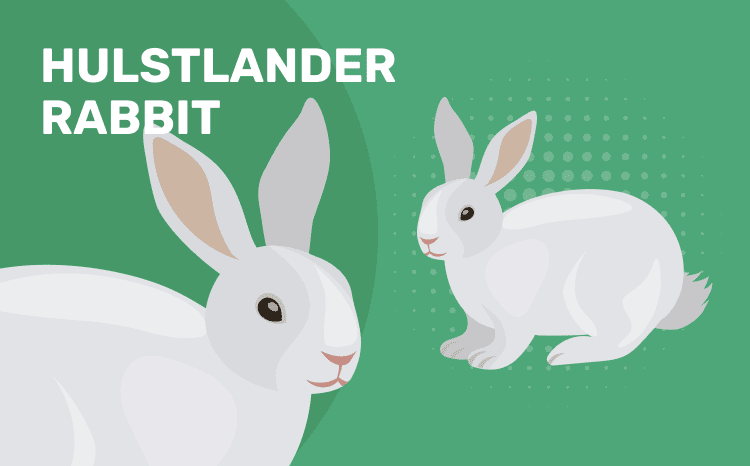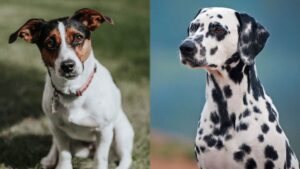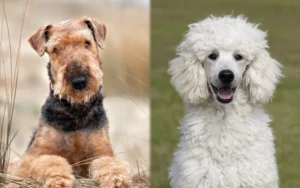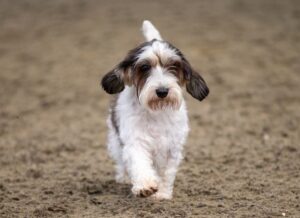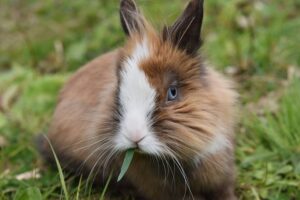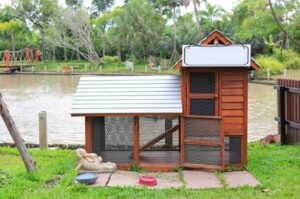The Hulstlander Rabbit, also commonly known as “Hussie,” originated in the Netherlands, named after the district of Hulstlander where the breed originated. The breed’s creator, J de Graaf, wanted to create a breed of rabbit that was pure white with blue eyes, and in the late 1970s, the Hulstlander was born. The breed was developed by crossing the blue-eyed Netherland Dwarf rabbit with a White Vienna.
It was only in 1984, however, that the breed was accepted by the Dutch National Rabbit Organization. Hulstlanders are truly unique, beautiful animals, and their endearing blue eyes and affectionate nature will quickly win your heart! Read on to learn more about this unique rabbit breed.

Quick Facts about Hulstlander Rabbits
| Species Name: | Hulstlander |
| Family: | Leporidae |
| Care Level: | Moderate |
| Temperament: | Friendly, curious, intelligent, playful |
| Color Form: | Pure white only |
| Lifespan: | 8-10 years |
| Size: | Small to medium (5-6 pounds) |
| Diet: | Herbivorous |
| Minimum Enclosure Size: | 12 square feet |
| Compatibility: | Friendly and highly compatible with other breeds |
Hulstlander Rabbit Overview
The Hulstlander Rabbit is known as a friendly, outgoing, and playful breed, with a healthy streak of mischievousness! They enjoy being handled and cuddled and are happy to be close to their human owners, when handled from a young age. In fact, these animals thrive off of human companionship and interaction and do not do well being left alone for long periods. If left alone too much or not handled regularly from a young age, they tend to be territorial and even aggressive at times.
Unusually among many rabbit species, Hulstlanders are easy to train and have a reputation for being able to learn tricks and even how to use a litter box! Some are also known to respond to their names when called. They’re clean animals that are easy to care for, are quiet, and have few housing needs, making them a popular breed in both the United States and abroad.
How Much Do Hulstlander Rabbits Cost?
The Hulstlander is a fairly rare breed that can be difficult to find, especially in the United States. For this reason, prices can vary widely depending on the breeder and availability. In general, you can expect to pay no less than $100 for a Hulstlander, and prices can reach up to around $300 in some cases, especially for show-worthy animals.

Typical Behavior & Temperament
Hulstlanders are friendly, outgoing, and playful animals that love to interact with their human owners. They’re also curious animals that are known for standing upright on their hind legs, sniffing out whatever scents they can, and often comically falling over in the process! When handled from a young age, Hulstlanders typically grow up to be highly affectionate animals that can potentially form powerful bonds with their owners and can recognize their owners by sight and voice.
Appearance & Varieties
Hulstlander Rabbits are always pure white with bright blue eyes and are small to medium in size, weighing in at between 5 and 6 pounds. They have short, compact, solid bodies with well-developed front and hindquarters. Their head is also short and compact, with thick large ears with rounded tips.
The Hulstlander’s beautiful white coat has a unique sheen to it, with a glossy and smooth appearance. The coat is medium length, with short guard hairs and a dense and thick undercoat. According to breed standards, there should be no trace of yellow or ivory in their coat, and they should have bright blue eyes — an unusual trait for a pure white rabbit.
How to Take Care of Hulstlander Rabbits
While Hulstlanders can be kept indoors, they are inquisitive and curious animals that love to explore outdoors too. Of course, their enclosure should be safe and escape-proof, as well as sturdy and secure enough to keep potential predators out, especially if they are kept outdoors. They’ll love exploring a grassy area with plenty of sunshine — although not too much, as they are prone to heatstroke — and adequate shade, with as much room to play and run as possible. Their enclosure should also be weatherproof: There should be a space that is warm enough in winter and shielded from the rain in the summer months. They’ll also need a separate quiet place to sleep, hide, and have alone time, whether inside or outdoors.
If you decide to keep your rabbit in a cage indoors, the cage should be as roomy as possible and at least five times the size of your rabbit. Of course, if they are kept in a cage, they should still have as much outdoor time as possible to stretch their legs, play, and explore. In their cage, they’ll need bedding, like straw or hay, to provide warmth and comfort and to promote their natural digging instincts.
Your rabbit will also need various toys to keep them sufficiently entertained and physically and mentally stimulated. This includes tunnels, ramps, balls, boxes, mazes, bells, and even old newspapers to tear up!
Do Hulstlander Rabbits Get Along With Other Pets?
Hulstlanders, like all rabbit species, are social animals that do best when paired with other rabbits. They can quickly become lonely and depressed, even with human companionship, and a bonded pair is the best way to keep your rabbit healthy and happy. These rabbits are generally docile and friendly animals, but same-sex pairings may lead to fighting. Unless you intend on breeding, a desexed male and female pair is ideal.
While Hulstlanders are friendly animals that are likely to get along with other pets, like dogs or cats, it’s best to keep them separated, as your dog or cat’s prey drive may just get the best of them!

What to Feed Your Hulstlander Rabbit
Like all rabbits, Hulstlanders need a diet high in fiber, ideally comprised of good quality hay and commercial rabbit pellets. Specially formulated rabbit pellets are ideal because they will provide for all your rabbit’s nutritional needs, and they are inexpensive and easily obtained. Hulstlanders can also be fed leafy green vegetables as a treat and even fruits on rare occasions. Keep fruits to a minimum, though, as they have high amounts of sugar, which is not good for the health of rabbits. Always make sure your rabbit has constant access to clean, fresh water.
Keeping Your Hulstlander Rabbit Healthy
The Hulstlander Rabbit is technically a hybrid breed, making them generally healthy animals that are free from any major genetic issues. That said, they are still prone to getting worms, parasites, or ticks if kept outside, so they should be treated accordingly. You’ll also need to provide them with plenty of fibrous foods and toys to gnaw on to keep their teeth strong, short, and healthy.
Without enough exercise, Hulstlanders can be prone to getting overweight or obese, so make sure they have adequate space to run and exercise in, or alternatively, make sure they are spending plenty of time playing outside of their cage.
Breeding
Hulstlanders breed fast, a common trait among all rabbit species, so unless you intend on breeding, you should have them desexed. These rabbits are usually sexually mature at 4-5 months old, and females have a gestation period of about 30 days. This means they can potentially have four to five litters a year, and you’ll quickly have a house full of rabbits if left unchecked!

Are Hulstlander Rabbits Suitable for You?
Hulstlander Rabbits are one of the most friendly, outgoing, and affectionate species of rabbits, and as such, they make great family pets. That said, young children should be taught to properly handle these animals, as they can get testy if mishandled. They are best kept outside in a large hutch with plenty of space to run and play, although they are well adapted to living indoors too.
Hulstlanders are social creatures that are best kept in pairs, but if given enough love and attention, they can live happily alone. They are intelligent animals that can learn tricks, respond to their name, and even recognize their owners, so these animals make great pets for anyone who has plenty of love, time, and attention to give!
- See also: Brazilian Rabbit
Featured Image Credit: You are free to use this image but we do require you to link back to Petkeen.com for credit
Contents
- Quick Facts about Hulstlander Rabbits
- Hulstlander Rabbit Overview
- How Much Do Hulstlander Rabbits Cost?
- Typical Behavior & Temperament
- Appearance & Varieties
- How to Take Care of Hulstlander Rabbits
- Do Hulstlander Rabbits Get Along With Other Pets?
- What to Feed Your Hulstlander Rabbit
- Keeping Your Hulstlander Rabbit Healthy
- Breeding
- Are Hulstlander Rabbits Suitable for You?

